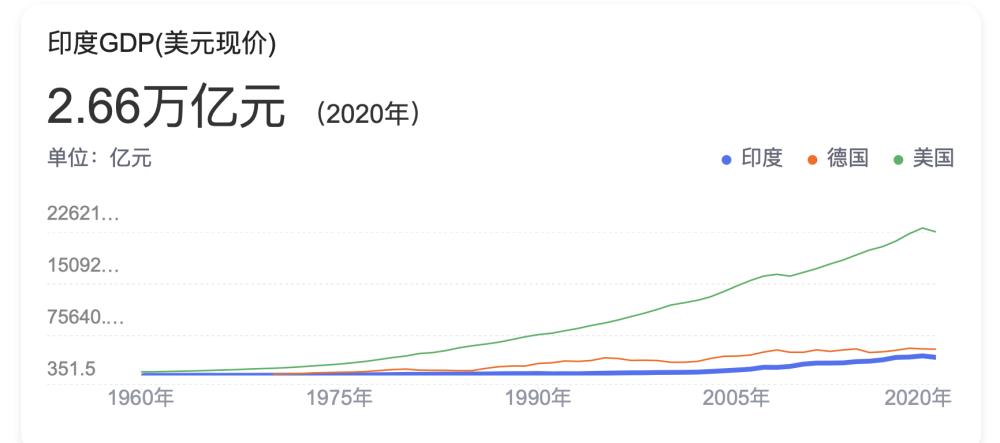Some industry bodies predict that by 2030, quantum technology may bring a cumulative value of $310 billion to India's national economy. In the whole year of 2020, India's total GDP was only 2.66 trillion yuan.

India's GDP over the years, picture from the Ceoche data
India even plans to develop a quantum computer with about 50 qubits by 2026. At the same time, the development of small-scale quantum devices such as quantum simulators and sensing is expected to be faster.
As early as 2020, India established the National Quantum Technology and Application Mission (NM-QTA) to officially join the global competition for quantum computing. In the same year, the Indian government approved the use of a $1.2 billion budget over five years to vigorously promote the development of quantum computing.
In its February 2022 report, The National Software and Services Industry Association of India (Nasscom) noted that India will play a key role in the quantum technology revolution.
The February 2022 report, "India's Quantum Technological Transformation – Investing in Gold on Quantum Hegemony," image from Nasscom
"The (Indian) government is empowering the scientific community to advance quantum science. India's leaders are planning to pour billions of dollars into the quantum ecosystem for technology commercialization and human resource development. The report reads.
Nasscom believes that under India's quantum development plan, the country will make leaps and bounds in quantum infrastructure over the next five years, mainly thanks to the government. "The government became a major supporter and sponsor of the India Quantum Initiative. Of the 100 quantum projects launched in India, about 92 percent are funded by the government. ”
India plans to invest $1.2 billion over the next five years to advance advances in quantum information and meteorology, quantum applications and materials, and quantum communications.
In fact, the European Union announced as early as 2016 that it would invest $1.13 billion in the quantum field, the United States released the National Quantum Protocol Act in 2018 and plans to invest $1.275 billion between 2019 and 2023, and the United Kingdom has invested more than $1.35 billion in its National Quantum Technology Initiative launched in 2014.
Since 2017, the mainland has built the National Laboratory for Quantum Information Science, and as the "No. 1 Project" of scientific and technological innovation in Anhui Province, the total investment of the first phase of the laboratory is as high as 7 billion yuan (about 1.1 billion US dollars).
The report predicts that India's quantum technology will reach a critical point of maturity by 2026-2027, with an increase in enterprise use cases. Areas such as manufacturing, high-tech, banking and defense will absorb 45% of investment funds and may be the first to adopt quantum technologies in large-scale application cases.
India's quantum ecosystem is already accelerating, with "10 to 15 government agencies, 20 to 30 service providers, 15 to 20 startups and 40 to 50 academic institutions active in this (quantum technology) space," local media said.
Acheyuta Ghosh, head of research at Nasscom, said many government agencies, academic institutions and startups have established commercially viable quantum computing application cases. Tata Consultancy Services, HCL Technologies, Infosys, Tech Mahindra, Zensar, Mphasis, Coforge and others are creating use cases and proofs of concept for quantum technologies for their customers.
In December 2021, Zapata Computing, an enterprise quantum software company, released its "first annual report on enterprise quantum computing applications," which included data from a survey of 300 large enterprise leaders around the world. According to the report, about 41% of respondents have started to apply quantum computing. It can be seen that the application cases of global enterprises for quantum computing are no longer in the minority.
In addition to India's quantum technology development program, Nasscom has seen significant progress in the country's field of quantum communication. "The current focus is on translating quantum key distribution (QKD) into field-deployable products and communicating via satellite and fiber," the report states. ”
At present, the mainland occupies the international frontier in the field of quantum communication. As early as September 2017, the world's first quantum secure communication trunk line developed by the mainland - the "Beijing-Shanghai Trunk Line" has been officially opened, combined with the "Beijing-Shanghai Trunk Line" and the "Mozi" of the heaven-earth link, mainland scientists successfully realized intercontinental quantum secure communication.
In addition, India even plans to develop a quantum computer with about 50 qubits by 2026, while the development of small devices such as quantum simulators and sensors is expected to be faster. Nasscom said India even has the potential to become an attractive country for quantum research and development, software development, component and equipment manufacturing.
But the development of quantum computers is inseparable from the development of electricity. India is still facing the normal problem of power outages. In July 2012, India's power outage became the world's largest blackout, affecting more than 670 million people in Europe, and in October 2021, it was once again on the verge of a national blackout, with a widespread blackout in and around Mumbai, India's financial center.
Akshe Mather, director of geoeconomic research at GatewayHouse, a well-known Indian think tank, once said: "India's rapid GDP growth now seems meaningless. Look at the millions of people still living in slums. In the face of such a huge disparity between the rich and the poor, 7% and 8% of GDP growth are simply negligible. Scholars must think independently about India's rise. ”